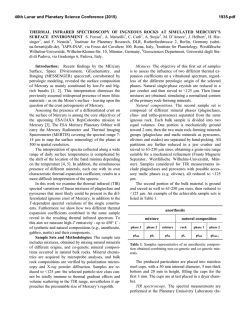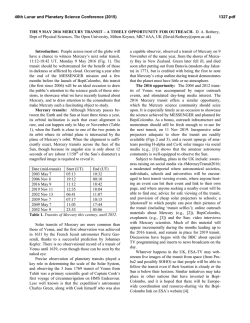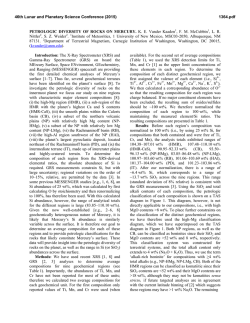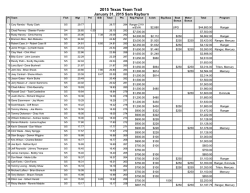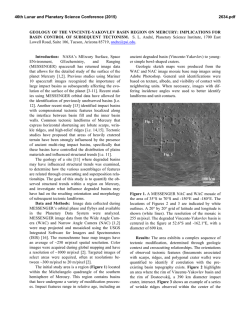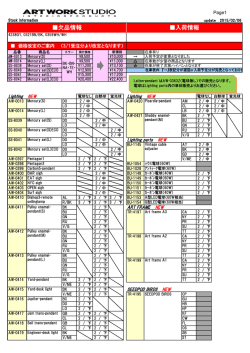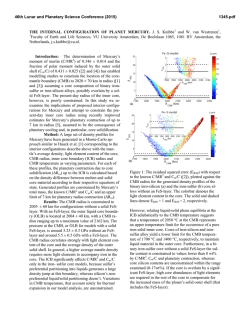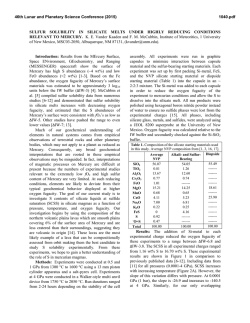
Spectrophotometric determination of mercury (II) in environmental
Available online at www.scholarsresearchlibrary.com Scholars Research Library Der Pharmacia Lettre, 2015, 7 (1):292-302 (http://scholarsresearchlibrary.com/archive.html) ISSN 0975-5071 USA CODEN: DPLEB4 Spectrophotometric determination of mercury (II) in environmental samples and synthetic mixtures using N'-(1-(pyridin-2-yl) ethylidene) isonicotinohydrazide as sensitive analytical reagent P. Nityananda Kumar Reddy1, G. Trivikram Reddy2, Kumar Ms. Sangita3, A. V. R. Reddy3, S. Nazneen Parveen1 and N. C. Gangi Reddy*2 1 Department of Environmental Sciences, Yogi Vemana University, Kadapa, A.P., India 2 Department of Chemistry, Yogi Vemana University, Kadapa, A.P., India 3 Analytical Chemistry Division, Bhabha Atomic Research Centre (BARC), Trombay, Mumbai, India _____________________________________________________________________________________________ ABSTRACT N'-(1-(Pyridin-2-yl)ethylidene)isonicotinohydrazide (2-ACPINH) is identified as a selective and sensitive analytical reagent for the determination of trace levels of mercury (II) in environmental samples and synthetic mixtures by spectrophotometry. 2-ACPINH reacts with mercury (II) forms greenish yellow colored 2:3 (Hg-2-ACPINH) complex at pH 5.5, in aqueous DMF. The Hg-2-ACPINH complex shows maximum absorbance at λmax 357nm. The color reaction is immediate and the absorbance remains constant for about 24h.The molar absorptivity coefficient and Sandell’s sensitivity are found to be 5.48x104 L.mol-1 cm-1 and 0.0010µg cm-2of mercury (II) respectively. The linear regression coefficient is 0.99925 and standard deviation is 0.04175. The system obeys Beer`s law in the range of 0.2-2.0 µg mL-1 of Hg (II). Large number of cations, anions and complexing agents do not interfere in this method. This method is successfully applied for the determination of mercury in a number of environmental water samples (potable and polluted), food samples and synthetic mixtures. _____________________________________________________________________________________________ INTRODUCTION Mercury can exist in several forms, and all forms are poisonous. The most common forms of mercury that occur naturally in the environment are metallic mercury. Microorganisms and various natural processes can change these forms of mercury, from one form to the other. Methyl mercury is the most common form produced by these natural processes. This compound is of particular concern because it can bio accumulate and biomagnify through the food chain1. Acute exposure of organic mercury affects the central nerves system which causes blindness, deafness, tremors, insomnia, memory loss, neuromuscular changes, headaches, slow sensory and slow motor nerve function and reduction in cognitive function. The consumption of inorganic mercury compounds causes metallic taste in the mouth, nausea, vomiting and severe abdominal pain2. Chronic exposure to mercury can result in several diseases, including, acrodynia (pink disease), neurological diseases, Hunter-Russell syndrome, mad hatters disease, leukemia and Minamata disease [3-8]. In contrast, some forms of mercury are relatively non-toxic and have been used as medicines e.g. for the treatment of syphilis [9]. Due to human activities major amount of mercury enters into the environment through chlor-alkali industries, plastic industries, electrical, paint and pharmaceutical industries [1015]. In addition, Mercury compounds are used as catalysts, fungicides, pesticides and also add mercury to the environment via the natural resources like water, food and igneous rocks, in particular granite for living organisms 292 Scholar Research Library N. C. Gangi Reddy et al Der Pharmacia Lettre, 2015, 7 (1):292-302 ______________________________________________________________________________ and additionally increases the danger of mercury exposure, even at trace levels [16, 17]. The environmental contaminants such as Pb2+, Cd2+ and Hg2+ have been exploited by a number of research groups [18]. All these findings cause great concern regarding public health, demanding an accurate determination of this metal ion at trace and ultra-trace levels. Several authors have reported on the determination of mercury (II) by using various ligands by spectrophotometry. However, the reported spectrophotometric methods [19-24] suffer from one or more disadvantages such as severe interferences, less sensitivity, less selectivity and difficulty in the preparation of reagent etc. However, none has been reported on spectrophotometric determination of Hg(II) in environmental samples using N'-(1-(pyridin-2yl)ethylidene) isonicotinohydrazide (2ACPINH) as analytical reagent. Herein, we developed a highly efficient spectrophotometric method for the determination of mercury (II) in environmental water samples (potable and polluted), food samples and synthetic mixtures using N'-(1-(pyridin-2yl)ethylidene)isonicotinohydrazide (2ACPINH) as sensitive and selective analytical reagent. Table. 1. Comparison of present method with other reported spectrophotometric methods Name of the reagent λmax pH Diacetylmonoximeisonicitinoylhydrozone (DMIH) 4-hydroxy3,5dimethoxy benzaldehyde -4hydroxy benzoylhydrazone Diphenylcarbazone(Dithiozone) 6-Hydroxy-3-(2-oxoindolin-3-ylideneamino)2-thioxo-2H-1,3thiazin-4(3H)one 375 8.0 0.8-8.0 ɛx104 (L mol1 cm-1) 1.8 351 5.5 1.0-12.0 2.29 420 4.0 0.60-2.70 505 4-6 0.2-2.0 2-Acetylpyridine Thio semicarbazone 351 Isonitriso p-isopropyl Acetophenone Phenyl Hydrazone (HIPAPH) 395 5.07.0 10.0 N'-(1-(pyridin-2-yl)ethylidene) isonicotinohydrazide (2ACPINH) 357 5.5 a Linearity range µg/mL M:La Ref. 1:1 [19] - [20] 4.56 - [21] 4.0 - [22] 0.24-2.40 5.4 1:2 [23] 1.0-20.0 2.678 1:2 0.2-2.0 5.48 2:3 [24] Present Method M:L is Metal (Hg) and ligand (2-ACPINH) ratio MATERIALS AND METHODS Apparatus A Double beam UV-Visible spectrophotometer (Shimadzu model UV-1800) with a 1.0 cm quartz cell is used for absorbance studies and pH meter (Systronics model 3305) is used for measurement of pH respectively. Melting point is determined and is uncorrected. Flame atomic absorption spectrophotometer (Shimadzu model No: AA6300). 1H NMR spectrum is recorded on Jeol 400 MHz NMR Spectrometer (JNM-400) and Mass spectrum is recorded on Shimadzu-LCMS with ESI probe (LC-2010EV). Reagents and solutions All the chemicals used are of analytical reagent grade or the highest purity available (Aldrich ACS or Merck proanalysis grade). DMF and Double distilled water are used though out. Preparation of N'-(1-(pyridin-2-yl)ethylidene)isonicotinohydrazide (2-ACPINH) Microwave method Isonicotinic acid hydrazide [7.3 mmol, 1.0 gm] and 2-acetyl pyridine [7.3 mmol,1.0 gm] are dissolved in 10 mL of ethanol in a 100-mL beaker and then 5% glacial acetic acid [2.5 mL] is added. The beaker is placed in a domestic microwave oven at 200 watts for 30-45s. The progress of the reaction is monitored by TLC. After completion of the reaction, the reaction mixture is cooled to RT. The formed crude product is washed twice with cold ethanol and dried. Finally, the obtained product is re-crystallized from hot ethanol. The structure of the synthesized compound is confirmed by 1H NMR and Mass Spectral data. 293 Scholar Research Library N. C. Gangi Reddy et al Der Pharmacia Lettre, 2015, 7 (1):292-302 ______________________________________________________________________________ O N O HN N O Ethanol Acetic acid N HN N N Ref lux NH 2 N'-(1-(pyridin-2-yl)ethylidene)isonicotinohydrazide (2-ACPINH) Scheme 1. Preparation of ligand, N'-(1-(pyridin-2-yl)ethylidene)isonicotinohydrazide (2-ACPINH) Characterization data of N'-(1-(pyridin-2-yl)ethylidene)isonicotinohydrazide(2-ACPINH) Yellow color solid; Yield: 1.88 g (95%); mp 220-222o C.; 1H NMR (400 MHz, DMSO-d6, δ/ppm): 11.12 (s, 1H, NH), 8.78 (d, 2H, J=4.4 Hz, arom H), 8.13 (d, 1H, J=8.0, arom H), 7.89 (d, 1H, J=5.6 Hz, arom H), 7.82 (d, 2H, J=7.2 Hz, arom H)7.65 (t, 1H, J=6.0 Hz, arom H), 7.46 (t, 1H, arom H), 2.513 (s, 3H, -CH3).; MS (ESI): m/z (M+H)+ 240.80. O N HN N N (2-ACPINH) Figure 1. 1H NMR spectrum of ligand, N'-(1-(pyridin-2-yl)ethylidene)isonicotinohydrazide (2-ACPINH) Preparation of 0.01 M of ligand, 2-ACPINH solution 0.01M of 2ACPINH reagent is prepared by dissolving 0.240 gm of 2-ACPINH in 100 mL of DMF. This stock solution is diluted further, whenever necessary with DMF. Preparation of mercury (II) stock solution 0.01M Mercury solution is prepared by dissolving 271.5mg of mercury chloride(Merck Darmstadt) in de-ionised water containing few drops of concentrated Hydrochloric acid and made up to the mark in a 100-mL volumetric flask. Aliquots of this solution are standardized with EDTA using xylenol orange as an indicator. Dilute solutions are prepared from this stock solution. Solutions of large number of inorganic ions and complexing agents are prepared from their analytical grade or equivalent grade, water soluble salts [25]. Preparation of buffer solutions Hydrochloric acid (1M) and Sodium acetate (1M) are mixed to get the required pH (1-3.5); 0.2M Sodium acetate and 0.2M Acetic acid are mixed to get the required pH (4-6) and Ammonium acetate buffer (pH 7) solutions are used. 294 Scholar Research Library N. C. Gangi Reddy et al Der Pharmacia Lettre, 2015, 7 (1):292-302 ______________________________________________________________________________ O N HN N N (2-ACPINH) Figure 2. Mass spectrum of ligand, N'-(1-(pyridin-2-yl)ethylidene)isonicotinohydrazide (2-ACPINH) Acetic acid and sodium acetate buffer solution of pH 5.5 is prepared by mixing 25 mL of 0.2 M acetic acid and required quantity of 0.2 M sodium acetate solutions. The pH of the above buffer solution is measured by a pH meter and finally adjusted suitably. General analytical procedure for the determination of mercury (II) An aliquot (2.0 mL) of the solution containing known amount of mercury (II), 4.0 mL of sodium acetate-acetic acid buffer solution (pH5.5) and 3.0 mL of 2ACPINH reagent of required concentration are mixed in a 10-mL volumetric flask and the resulting solution is diluted up to the mark with double distilled water. The absorbance of this solution is measured at 357nm, against ligand blank. RESULTS AND DISCUSSION N'-(1-(pyridin-2-yl)ethylidene)isonicotinohydrazide reacts with Mercury (II) forms a greenish yellow colored complex in aqueous DMF at pH 5.5. The Hg-2ACPINH complex shows maximum absorbance at λmax 357nm against the reagent blank. Hence, a detailed study has been undertaken for the determination of Mercury (II) using 2ACPINH by spectrophotometric method. The optimized method is successfully applied for the determination of mercury in water samples, food samples and synthetic mixture alone or in presence of diverse ions. Absorption spectra of ligand, 2-ACPINH and Hg(II)-2ACPINH complex (MLC) Absorption spectrum of the 2ACPINH is recorded against the solvent blank initially. The absorption spectrum of Hg(II)-2ACPINH complex is recorded against the reagent blank. The absorption spectrum of both complex and ligand are shown in Figure 3. From the absorption spectra, it is clear that the ligand shows maximum absorption at 284 nm where as the complex shows maximum absorption at 357 nm. Therefore, all the spectral measurements are carried out at 357 nm. 295 Scholar Research Library N. C. Gangi Reddy et al Der Pharmacia Lettre, 2015, 7 (1):292-302 ______________________________________________________________________________ Figure 3. (A) Absorption spectrum of ligand (2ACPINH) Vs. solvent (DMF) blank (B) Absorption spectrum of Hg(II)-2ACPINH complex (MLC) Vs. Ligand blank; Hg(II) = 2.0 mL of 1.0x10-4M, 2ACPINH = 3.0 mL of 1.0x10-4M and pH = 5.5. Figure 4: Effect of pH on the absorbance of Hg (II)-2ACPINH complex; Hg (II) = 2.0 mL of 1.0x10-4 M; 2ACPINH=3.0 mL of 1.0x10-4M; λ max = 357 nm 296 Scholar Research Library N. C. Gangi Reddy et al Der Pharmacia Lettre, 2015, 7 (1):292-302 ______________________________________________________________________________ Effect of pH Into a series of 10-mL volumetric flasks, 2.0 mL of Hg (II) solution (1.0x10-4M), 3.0 mL of Ligand solution (1.0x104 M), and 4.0 mL of buffer of varying pH (1.0-7.0) are added and made up to the mark with double distilled water and the absorbance is measured against ligand blank at 357 nm. The absorbance increases from pH 1.0 to 5.5 and then decreases. Hence, pH5.5 is optimized for further studies (Figure 4). Applicability of Beer’s law The known aliquots of 10.0 mL solutions, each containing constant volumes of 4.0 mL of buffer (pH 5.5), 3.0 mL of 1.0×10-4M of reagent and 2.0 mL of mercury (II) solutions of concentrations in the range from 0.10×10-4 to 1.0×104 M (0.2-2.0 µg mL-1) are prepared. The absorbance of these solutions is measured at 357 nm. A graph plotted between the amount of Mercury (II) and its absorbance is shown in Figure 5. It can be observed from the graph that, a linear plot passing through the origin obeys Beer’s law in the range from 0.2-2.0 µg mL-1 of Mercury (II). The correlation coefficient is 0.99925 which indicates the linearity between the two variables. The molar absorptivity coefficient and sandal’s sensitivity of the complex are found to be 5.48x104 L mol-1 cm-1 and 0.0010µg cm-2, respectively. Figure 5. Effect of Metal concentration- 2ACPINH = 3.0 mL of 1.0x 10-4M, Hg(II) = 2.0 mL of (0.1x10-4M - 1.0x 10-4 M), pH = 5.5 and λ max= 357 nm Job’s method of continuous variation Equi-molar solutions of mercury (II) ion and ligand 2ACPINH (1.0×10-4M concentration each) is prepared. The metal and reagent solutions are mixed in different proportions, keeping the total volume of metal and ligand is constant at 5.0 mL. In each case, 4.0 mL of sodium acetate-acetic acid buffer (pH 5.5) is added to the mixture and the total volume of the solution is made up to 10.0 mL with double distilled water. The absorbances of all the solutions are measured at 357nm against their reagent blanks. The corresponding graph (Figure 4) is drawn between absorbance and VM/VL+VM (where VL and VM are the volumes of the reagent and the metal, respectively) indicates that two moles of Mercury(II) reacts with three moles of ligand and the composition of metal to ligand complex as 2:3 ratio (Figure 6). The composition of the M-L complex is further confirmed by Molar ratio method (Figure 7). 297 Scholar Research Library N. C. Gangi Reddy et al Der Pharmacia Lettre, 2015, 7 (1):292-302 ______________________________________________________________________________ Figure 6. Jobs method of continuous variations for stoichiometric ratio between Hg(II) and 2-ACPINH (1.0×10-4M concentration each); pH = 5.5 and λ max = 357 nm Figure 7. Effect of Ligand concentration: 2ACPINH=3.0mL of (1.0x 10-5 -3x10-4M), Hg(II)=2.0 mL of (1.0x 10-4 M), pH=5.5 and λmax=357nm 298 Scholar Research Library N. C. Gangi Reddy et al Der Pharmacia Lettre, 2015, 7 (1):292-302 ______________________________________________________________________________ Mole ratio method Effect of ligand concentration In to a 10-mL volumetric flask 2.0 mL of 1.0x10-4M Hg(II) solution,4.0 mL of buffer pH5.5 and 3.0 mL of varying amounts of (1x10-5 to 3.0x10-4M) ligand (2-ACPINH) are added and made up to the mark with water and measured the absorbance at 357 nm against the corresponding ligand blanks. From the results, it is clear that 3.0 moles of ligand is necessary for the maximum recovery of 2.0 moles of Hg (II). The results are plotted in Figure 7. Effect of metal ion concentration: Different molar excesses of Hg(II) are added to the fixed amount of 2-ACPINH and absorbance is measured according to the standard procedure. It is observed that the reagent and the Hg(II) metal molar ratio is 2:3. Based on the above two methods the composition of the Hg(II)- 2ACPINH complex is confirmed as 2:3 ratio (Figure 8). Figure 8: Effect of Metal concentration: 2ACPINH=3.0 moles of 1.0x 10-4 M, Hg(II)=2.0 moles of (0.1x10-4M-1.0x 10-4 M), pH=5.5 and λmax=357nm. Effect of foreign Ions The effect of various cations and anions which are generally associated with the metal ion on the determination of the mercury (II) is studied by measuring the absorbance of the mercury complex containing 1µg mL-1 of mercury (II) in solution. The effect of foreign ions on complexation is studied by taking 1.0 mL of Hg(II) solution, 1.0 mL of required concentration of the foreign ion solution, 4.0 mL of sodium acetate acetic acid buffer (pH 5.5) and 3.0 mL of 2ACPINHsolution in a 10-mL standard flask. The total volume of the solution is brought to 10.0 mL with double distilled water. The experiment is repeated by changing the concentration of the diverse ion. The absorbance is measured at 357 nm. A change of ± 0.02 is taken as the tolerance limit for interference. The results indicated that Ca(II), Mg(II), Pb(II) and Mn(II) do not interfere even when present up to 10000 µg. Interference due to Al(III) and Cr(III) can be tolerated up to 5000 µg, whereas Mo(VI)and W(V) can be tolerated up to 2500 µg only. Extraction of copper (II) is not possible in the presence of Co(II), Ni(II), Fe (II)/Fe(III), Zn(II), Pd(II), and Cd(II), due to their severe interference, even when present in trace amount. Anions such as fluoride, bromide, chloride, nitrate, sulfate, thiosulfate and acetate do not affect the extraction of mercury (II), even when present up to 5000 µg. In the presence of thiocyanate and oxalate, extraction of mercury(II) is not possible. 1.0 mL of 0.2% sodium fluoride has been used as a masking agent for Fe(III) and 1% potassium iodide for Ni(II), Co(II). Zn(II) and Cd(II) do not interfere in the pH range studied. 299 Scholar Research Library N. C. Gangi Reddy et al Der Pharmacia Lettre, 2015, 7 (1):292-302 ______________________________________________________________________________ Table. 2: Physico-chemical and analytical characteristics of Hg(II)-ACPINH complex (MLC) Obtained Results Characteristics of MLCa λmax(nm) 357 pH range (optimized) 5.5 Mole ratio of M:L 2:3 Beer’s law validity range(µg/mL ) 0.2-2.0 Molar absorptivity coefficient (lit mol-1 cm-1 ) 5.48x104 Sendell’s sensitivity (µg of Hg(II) cm-2 ) 0.0010 a MLC is Metal-ligand complex SCOPE OF THE METHOD The present method is successfully applied to the determination of mercury when present alone or in presence of diverse ions. The method is also extended to the determination of mercury in environmental samples, food samples and synthetic mixtures. Determination of mercury in environmental water samples Different water samples are collected from in and around KADAPA, A.P. India. Each filtered water samples is evaporated nearly to dryness with a mixture of 5.0 mL of concentrated H2SO4 and 10.0 mL of concentrated HNO3 in a fume cupboard and then cooled to room temperature. The residue is then heated with 10.0 mL of double distilled water, in order to dissolve the salts. The solution is cooled and neutralized with dilute NH4OH in the presence of 1–2 mL of 0.01% (W/V) tartarate solution. The resulting solution is filtered and quantitatively transferred into a 25-mL calibrated flask and made up to the mark with double distilled water [26]. Table 3. Determination of mercury(II) in water samples Concentration of Found concentration of Recovery (%) Hg(II) by AAS Method Hg(II) 100 100.028 100.03 100.03% Waste water1 500 500.16 500.15 100.03% 100 100.036 100.034 100.034% Sea water2 500 500.19 500.17 100.034% 100 100.0 100.0 100.0% Tap water3 500 500.01 499.98 99.99% 1 Collected from industrial area, Kadapa.; 2Bay of Bengal,Nellore.; 3Yogi Vemana University, Kadapa. Sample Mercury (µg/L)- (Spiked) added Determination of mercury in food samples Food samples are collected from various villages around Kadapa, A.P. India. The samples are cleaned and dried in open air, protecting them from mineral contamination. The dried sample is pulverized in a mortar for the purpose of analysis, to a convenient size. One gram of powdered food sample is taken in a 100-mL beaker and digested with 10.0 mL of concentrated Nitric acid and Hydrochloric acid [27]. Further add 10.0 mL of double distilled water and then filtered by using Whatmann No.41 filter paper. The filtrate is taken in a 10-mL standard flask made up to the mark with double distilled water and analyzed as per the general procedure. Table. 4 : Concentration levels of mercury in food samples S. No. Name of the food sample 1 2 3 4 5 Wheat grain (Triticum aesivum) Cabbage (Brassica oleracea) Carrot (Daucas carota) Potato (Solanum tuberosum) Tomato (Lycopersicon esculentum) Concentration of mercury (Hg) determined by AAS Method (ppm) 0.012 0.066 0.060 0.098 0.13 *Average of five readings Concentration of mercury (Hg) in the present method (ppm)* 0.01 0.063 0.057 0.093 0.11 Standard Deviation 0.001414 0.002121 0.002121 0.003536 0.014142 Preparation of Synthetic mixtures Metal ion solutions of Cu2+, Fe2+, Co2+, Ni2+, Mn2+, Zn2+, Hg2+, Pd2+, Cd2+ and Pb2+ are prepared from Merck analytical grade stock standards of concentration 1000mg/l. The synthetic water solutions are then prepared by mixing the different metal ions as prescribed in the table.5. The aliquot is analyzed for Hg(II), using 2HAPINH adopting the recommended procedure. 300 Scholar Research Library N. C. Gangi Reddy et al Der Pharmacia Lettre, 2015, 7 (1):292-302 ______________________________________________________________________________ Table. 5: Determination of Hg(II) in Synthetic mixtures Sampl es 1 2 3 4 5 Metal 1 (2µg/mL) Fe Co Fe Cd Cu Metal 2 (2µg/mL) Co Ni Zn Pb Pd Metal 3 (2µg/mL) Ni Mn Ni Ni Mn Metal 4 (4µg/mL) Hg Hg Hg Hg Hg AAS (µg/mL 3.98 3.99 3.97 3.96 3.98 Present Method (µg/mL) 3.94 3.95 3.93 3.96 3.97 % of recovery 98.5 98.75 98.25 99.25 99.50 CONCLUSION We demonstrated a simple and efficient spectrophotometric method for the determination of Hg (II) in water samples, food samples and synthetic mixtures using highly sensitive and selective N'-(1-(Pyridin-2yl)ethylidene)Isonicotinohydrazide as an analytical reagent. It can be used as an alternative method for routine quality control analysis of Hg(II). The proposed method offers advantages like good sensitivity, selectivity, reliability, reproducibility, less interference and immediate color development. The developed method is found to be quantitative comparable to other standard methods. The molar absorptivity of the complex (5.48 x104 L mol-1cm-1) reveals that the ligand is highly sensitive for mercury (II) when compared with other hydrazones. A number of associated elements don’t interfere in the determination of Mercury. Hence, 2ACPINH is an alternative ligand for the spectrophotometric determination of amount of Mercury (II) in low and trace levels from various natural water and food samples. Acknowledgement We gratefully acknowledge the financial support of this work from the Department of Atomic Energy-Board of Research in Nuclear Sciences (DAE-BRNS) (Bhabha Atomic Research Centre), Mumbai, India through a major research project (No. 2011/37C/52/BRNS/2264). REFERENCES [1] S. M. Harmon; Anthropogenic Mercury Pollution In Aquatic Systems: a Review of Environmental Fate and Human Health Risks. SÁNCHEZ, M. L. (Ed), Causes and Effects of Heavy Metal Pollution, (New York: Nova Science Publishers, 2008), 173. [2] B. Venugopal and T. D. Lucky; Metal Toxicity in Mammals (Plenum Press, New York, 1978, Vol. 2), 86. [3] Agency for Toxic substance and Disease Registry ATSDR, (1999), Toxicology profile for mercury, Public Health service, Atlanta. [4] M. E. Stone; M. E. Cohen; L. Liang and P. Pang, Dent. Mater., 2003, 19, 675. [5] J. E. Fergusson; The Heavy Elements: Chemistry, Environmental Impact and Health Effects, Pergamon Press, Oxford, 1990. [6] M. O. Amdur; J. Doull and C. D. Klaassen; (4th ed.) Casarett and Doull’s Toxicology: The Basic Science of Poisons. (New York, NY: McGraw-Hill, 1993), 623. [7] K. Janicki; J. Dobrowolski and K. Krasnicki, Chemosphere, 1987, 16, 253. [8] Y. Kinjo; S. Akiba; N. Yamaguchi; S. Mizuno; S. Watanabe; J. Wakamiya; M. Futatsuka and H. Kato; J. Epidemiol, 1996, 6, 134. [9] V. P. Kudesia; Toxicity of metals in Air Pollution (Pragati Prakashan, Meerut, 1988), 178. [10] A. K. De, Second Environmental Chemistry (Wiley Eastern Limited, New Delhi, 1989), 75. [11] Agency for Toxic Substance and Disease Registry ATSDR, (1999), Toxicology profile for mercury, Public Health Service, Atlanta. [12] C. D. Klaassen; Casarette and Doull’s Toxicology (McGraw-Hill, New York, 2001), 834. [13] P. O’Neil; Second Mercury in Environmental Chemistry (Chapman and Hall, London. 1995). [14] B. B Petkovic; R. M Simonovic and R. J Micic; J. Ana. Chem., 2007, 62, 697. [15] W. Qin; C. Guohua; Y. Jinhu and D. Bin; Ana. Lett., 2003, 36, 627. [16] M. Saber-Tehrani; H. Hashemi-Moghaddam; M. H Givianrad and P. A. -A. Anal; Bioanal. Chem., 2006, 386, 1407. [17] J. L. Manzoori; M. H. Sorouaddin and A. M. Hajishabani; J. Anal. Atom. Spectram., 1998, 13, 305. [18] T. C. Hutchinso and K. M. Meema (Scope. 31), Lead, Mercury, Cadmium and Arsenic in the Environment (Pergamon Press, Oxford, 1987)365. 301 Scholar Research Library N. C. Gangi Reddy et al Der Pharmacia Lettre, 2015, 7 (1):292-302 ______________________________________________________________________________ [19] H. Khan and M. J. A.Bhanger; Anal. Sci, 2005, 21, 507. [20] K.Vasudeva Reddy, S.Vidysagar Babu, K. Hussain Reddy, J. Ind. Chem. Soc., 2009, 86, 162. [21] D. Nagarjuna Reddy, K. Hussain Reddy, Ultra chemistry, 2010, 6, 287. [22] D. Gopalakrishna, Ch. Kethani Devi, Ind. J. Green Chem., 2011, 1, 10. [23] S. Vidyasagar Babu, K. Hussain Reddy, Ind. J. Adv. Chem. Sci. 2012, 1, 65. [24] B. Sreenivasa Rao, D. Som Shankar, B. Venkata Kiran, Int. J. Life Sci. Phar. Sci. 2011, 1, 75. [25] A. I. Vogel, (2nd), A Textbook of Quantitative Inorganic Analysis (Longman Green, London. U.K. 1961). [26] S. Adinarayana Reddy, K. Janardhan Reddy, A. Varada Reddy, J. Chin. Chem. Soc., 2010, 57, 236. [27] S. Satyaveni, PhD thesis, Sri Venkateswara University (Tirupati, AP, 2007). 302 Scholar Research Library
© Copyright 2024
